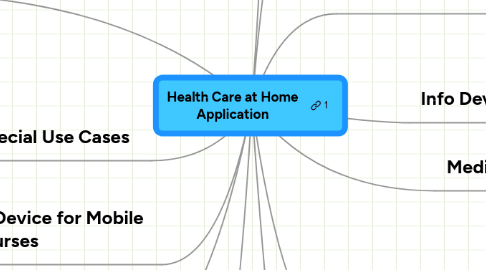
1. Monitoring Device
1.1. User Groups
1.1.1. Elderly People Alone at Home
1.1.2. Risk Groups (e.g. Heart Patience)
1.1.3. Athletes
1.1.4. Handicapped
1.2. Sensor Data
1.2.1. Blood Presure
1.2.2. Hearth Rate
1.2.3. Other Blood Diagnostics (Colesterol)
1.2.4. Sweat Level (indicating Stress)
1.2.5. Position (GPS)
1.2.6. Communication with implants
1.2.7. Blood Sugar
1.2.8. Body Weight
1.2.9. egesta
1.3. Actions
1.3.1. Call Emergency
1.3.2. Give Medication
1.3.3. Alert User
1.3.4. Contact doctor
1.3.4.1. Synchronous (Phone Call / Video Chat)
1.3.4.2. Asynchrous (SMS / Email)
1.3.5. Different Actions for Different Sensor Levels
1.3.6. use ubicomp device to monitor
1.3.7. Contact relative (emergency contact)
1.3.8. Display first aid instructions
1.4. Device may have a "sign on/off" function (for going to bed / shower)
1.5. If device needs to be monitoring during sleep, it has to be designed, so it cannot fall off accidently
2. Supportive Device for Mobile Doctors / Nurses
2.1. Device to record and display health informations
2.2. May be to complex for scope of DIS project
2.3. Telehealth Support
3. Drug-stores (aka pharmacy)
3.1. view on map w/ contact details
3.2. see list of available medicines
3.3. order required medicine
3.4. see similar medicines
4. Benefits of Home Device/Application
4.1. For the user
4.1.1. Independence
4.1.2. Security
4.1.3. Savety
4.1.4. Higher quality of care
4.2. For the doctor
4.2.1. More data -> better diagnostics
4.2.2. earlier notification/treatment
4.2.3. real time data
4.3. For the health system
4.3.1. One doctor can deal with more patients
4.3.2. Health care in rural areas
5. Special Use Cases
5.1. Health care for rural areas
5.2. Health care for poor/developing areas (mobile communication infrastructure often exists)
6. Diagnostic Device
6.1. Analyse Body Fluids
6.1.1. Blood (e.g. HIV ?)
6.1.2. Urin (e.g. Pregnancy)
6.2. Analyse drinking water (safe to drink?)
7. Medication Device
7.1. Remember prescribed medication
7.2. Alert when medication is due
7.3. Store the pills
7.4. Inject medication
7.5. Control medication level (e.g. blood sample)
7.6. Special Use Case: Diabetes
7.6.1. Inject insulin
7.6.2. monitor blood sugar
7.6.3. alert user
7.7. Needs different modes for user and doctor
8. Medical file storage
8.1. Saves important medical data
8.2. Available for different doctors and users
8.3. No device for UI design project?!
9. Special Requirements
9.1. Of Old People
9.1.1. Bad Sight
9.1.2. Not Familiar with modern technology
9.1.3. Bad Hearing
9.1.4. Clumsy (Device has to be robust)
9.2. Of Handicapped People
9.2.1. Blind (Braille Printing)
9.2.2. Limited Motion (Fine Motor Skills)
9.3. Of Mobile Devices
9.3.1. Robust
9.3.2. Maybe wearable design (e.g. bracelet)
9.3.3. Waterproof
9.3.4. Wireless Connection (WLAN / UMTS)
9.3.4.1. Offline Mode
9.3.4.2. Bulk Upload When Reconnecting
9.3.5. Battery Powered
9.3.6. Maybe synchronise with PC when at home
9.3.7. Application may be own device or software for existing hardware (PDA / iPhone)
10. Aspects of User Scenarios
10.1. User lives alone
10.2. User lives in isolated area
10.3. User is in treatment at a specific doctor
10.4. User can maintain independence through using the device/application (otherwise he may have stationary treatment)
11. Info Device
11.1. Display first aid instructions
11.2. Searchable "Hausmittel" (Self Medication) Info
11.3. Self Diagnostic Info
12. idea stephan
12.1. FACT monitoring devices on the way
12.1.1. http://download.intel.com/healthcare/pdf/Health_Guide_Brief.pdf
12.1.2. http://www.research.ibm.com/journal/sj/461/blount.html
12.2. PROBLEM patient has no advantages
12.2.1. devices focus on transmission of data from the patient to the doctor
12.2.2. good for the doctor, who does not need to see the patient in persona
12.2.3. what about the patient?
12.2.3.1. back in the days: the doctor interpreted the data and told the patient
12.2.3.2. to come: patient is at home and has no clue what is going on.
12.2.4. GAP OF EVALUATION
12.3. BRIDGE THE GAP - make the user know what's going on
12.3.1. no fancy hardware o fancy features
12.3.2. just an interface to help the patient understand his condition
12.4. possible project names
12.4.1. the hypochonders wet dream
